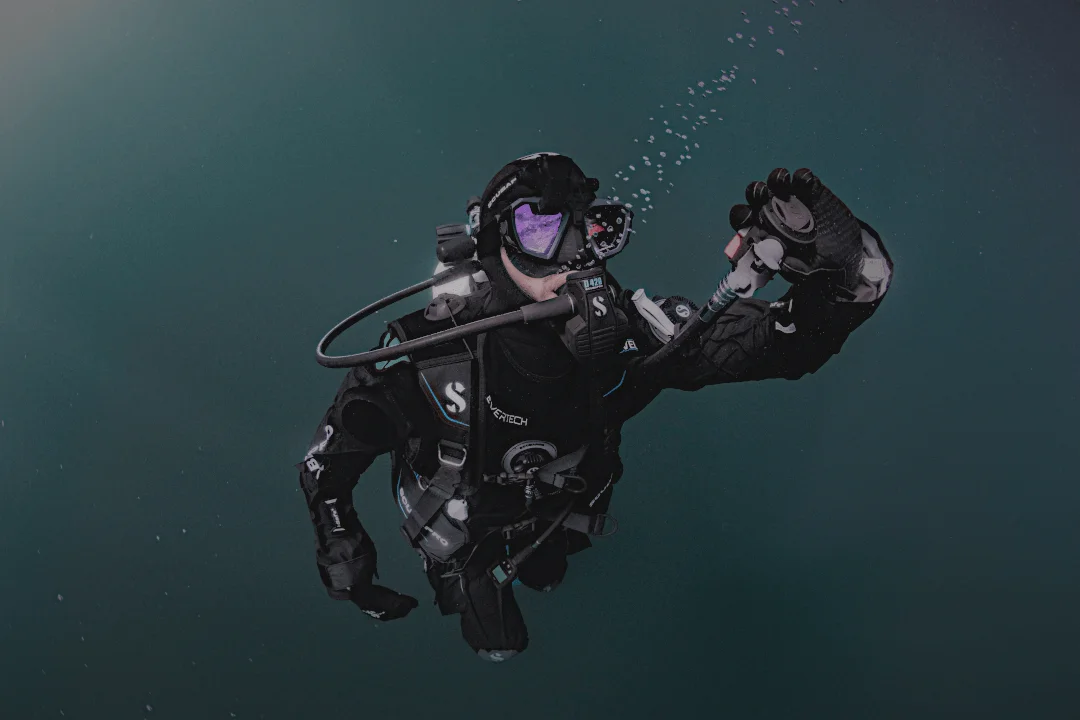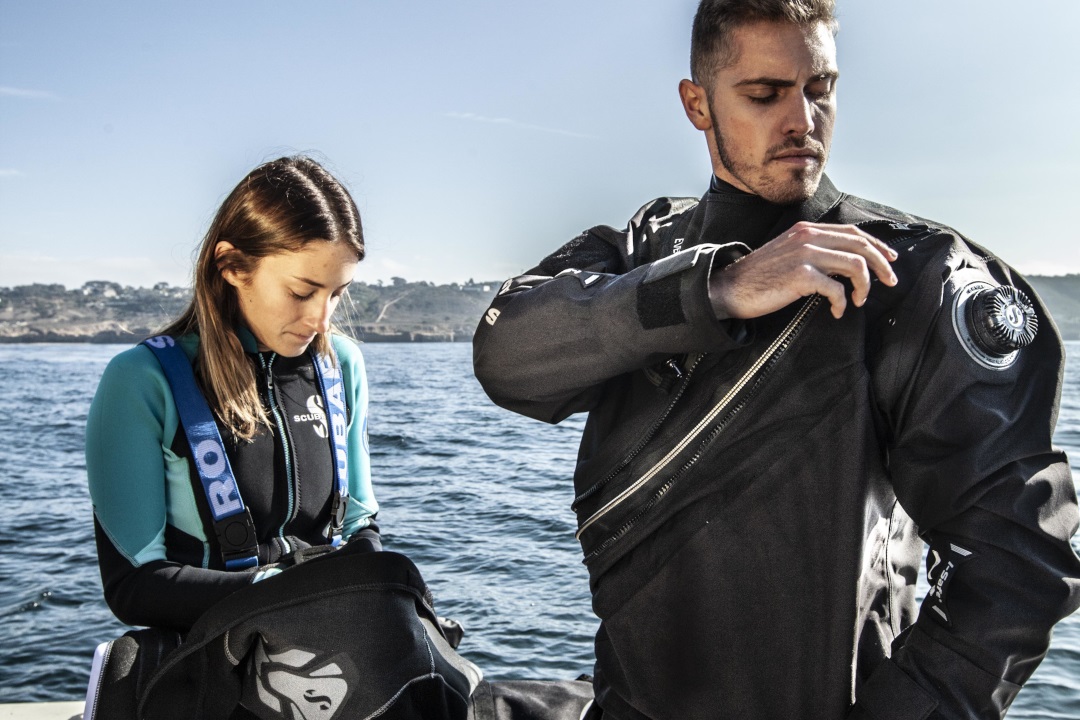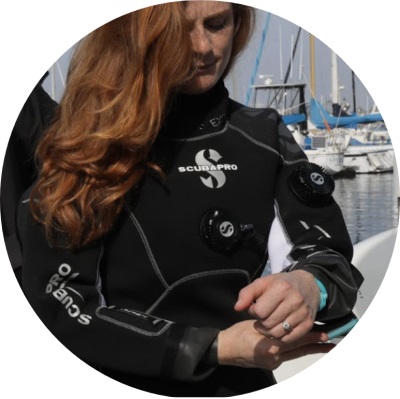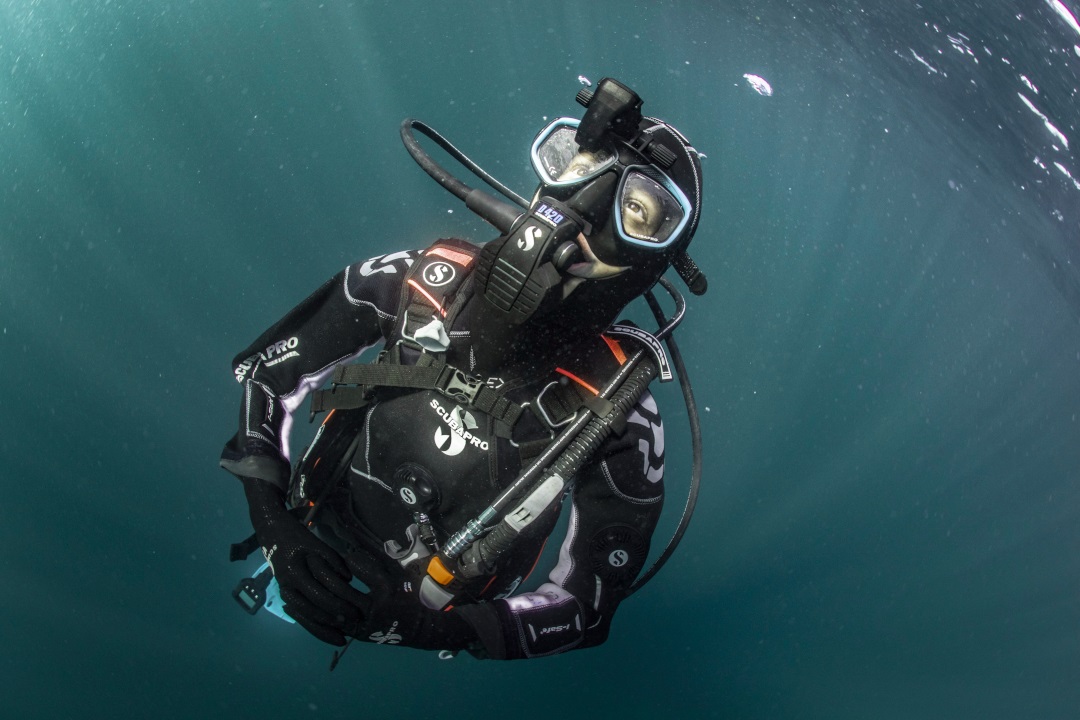Drysuit Diving: Tips to Improve Comfort and Performance

Drysuit Diving: 6 Tips to Improve Comfort and Performance
Diving in a drysuit is something you must experience to fully appreciate. When you're wearing a drysuit it doesn't really matter how cold the water is or how deep you're going to be drysuit diving because you can regulate your at-depth comfort by varying your thermal protection and by adding air to the suit. Being able to cruise around under water while remaining dry helps enable you to enhance your overall comfort level and extend your bottom times far beyond what a wetsuit diver could only dream of.
But drysuit diving is a bit more complex than wetsuit diving, involving additional components (dry seals, waterproof zippers, undergarments, etc.) as well as some different diving skills. Here are a few tips to help get you started down the drysuit diving path.
1. Fit is foremost.
Making sure your exposure protection fits is important in all types of scuba diving, but especially in drysuit diving, and even more so when it comes to trilaminate drysuit diving. As opposed to neoprene drysuits, trilaminate suits offer little to no stretch, so it's particularly important to size your suit so that it's loose enough to enable you to have full freedom of movement, but snug enough to avoid excessive air shifting inside the suit along with the hydro-drag that occurs when you're dragging too much extra material through the water with you.
Here's a good fit test: Try on the drysuit you have selected with the undergarments you are going to be wearing, and go through a range of motion test. Sit, squat and bend your knees as if you were putting on fins, roll up in a ball, reach one arm across to the other arm. These motions are all important to your ability to move and function comfortably under water. At the same time, be thinking about streamlining, which can often be difficult when you're simultaneously trying to keep the suit loose enough to maintain freedom of movement.
One way to do this is to look for trilam drysuits that offer telescoping torsos. The Evertech Dry Breathable, for example, is designed with a telescoping torso that provides extra material in the critical torso area to increase range of motion. At the same time, its design enables you to rein in any extra material by folding it under and cinching it down with a crotch strap, thereby maintaining a more streamlined, hydrodynamic profile.

2. Choose your undergarment wisely.
Investing in a top-line drysuit and then scrimping on your insulating undersuit is a sure way to sabotage your entire drysuit diving system. Drysuit undergarments come in a variety of designs and materials, in two basic styles: two-piece shirt/pant combos, and one-piece jumpsuits.
Two-piece combos are convenient because you can buy the tops and pants separately, which can help fine-tune fit, but they can hike up or down at depth which can expose some skin to the cold. One-piece jumpsuits won't leave a gap at your equator, but they can inhibit mobility if not designed correctly. The K2 Extreme is an example of a jumpsuit done right. Made of a breathable and stretchy dual fleece material, it includes compression padding for both comfort and protection, elastic wrist loops and heel straps to prevent ride-up, plus provides holes on the legs that can be adapted to P-valves (see below).
Bottom line: The type of undergarment you choose for drysuit diving will play a large role in whether you're warm and cozy, or cold and restricted, regardless of what drysuit you're wearing.

3. Don't overlook the seals.
Seals at the neck and wrists of a drysuit are either neoprene or latex. Most neoprene drysuits use neoprene seals (an exception is the Exodry, a popular neoprene drysuit featuring latex seals). Neoprene seals have inherent thermal properties, adding to at-depth comfort. Some are smooth-skin-out designs – once your head and hands are through the nylon openings, you fold the seals under, placing the smooth side against your neck and wrists, creating a comfortable seal. Others are skin-in. They are less bulky because no folding is required; however, they are a little harder to don.
Most trilaminate drysuits use latex seals. Latex seals provide excellent watertight seals but have no thermal properties. They offer some advantages over neoprene seals in manufacturing and some are even designed to be field-replaceable. The Evertech Dry Breathable comes with a Si-Tech ring latex seal system for wrists and neck that allows for the quick replacement of damaged latex seals, or for the use of optional silicone seals for divers who are allergic to latex.
For drysuit divers who, due to the sizes or shapes of their necks and wrists, have difficulty maintaining a watertight seal, there is a product called the BioSeal designed to act as an inter-seal between a drysuit's neck and/or wrist seals and a diver's skin. Slip an elastic BioSeal over the neck or wrist, smooth it against the skin, then roll the drysuit seal over it. The BioSeal seals on the body's skin, the drysuit seals on the BioSeal. It's a very effective sealing system for divers who have trouble maintaining watertight seals, and it works on both neoprene and latex seals, although latex seals need to be thoroughly cleaned after each use.

4. Proper weighting for maximum warmth.
Nobody likes to carry extra weight, but that's the price we pay for being able to explore the underwater world. It's always good practice to strive to trim your weight load to the absolute minimum, but when wearing a drysuit sometimes this strategy can work against the thermal attributes of the suit's design, creating discomfort, plus it can be downright unsafe.
In addition to the thermal properties of the undersuit, a drysuit keeps you warm by enabling you to add air to the suit via a low-pressure hose tied into your regulator that connects to the drysuit inflation valve. This air is also used to adjust buoyancy, plus as you descend and the suit compresses, adding air prevents painful squeeze (when pockets of air get trapped in the folds of the drysuit that compress and pinch).
Here's the issue: When you trim down your weight load too much, you're often not able to put enough air in the suit for warmth and to prevent squeeze without creating positive buoyancy, opening the door to a potential uncontrolled ascent situation.
So you don't want to overload your weight pouches, but at the same time, you want to carry enough weight to help enable you to add air as you descend and start experiencing squeeze and start getting colder. The amount of weight you'll need depends on the suit and the type/thickness of undergarment you're using, as well as your personal comfort level. Invest the time to determine your correct weight requirements. It's going to probably take at least a few dives to accurately dial it all in, but you'll be glad you did.
5. Maximize your buoyancy control.
When diving in a drysuit, most divers will transfer their buoyancy control functions from their BCDs to their drysuits. In other words, during a dive the BCD tends to be kept empty, while buoyancy is controlled by pumping air into the drysuit on descents, and venting air out of the suit on ascents. This avoids possible confusion when having to deal with two inflation/deflation systems –
the drysuit for thermal comfort, and the BCD for buoyancy control, which can lead to a sudden uncontrolled ascent.
This method actually works quite well. The BCD stays empty. As you descend and you're getting colder, experiencing compression and maybe increasing descent speed, a few bursts of air into the suit warms the suit, stops suit squeeze and slows the descent. Upon ascent, as the air inside the suit expands, activating the manual or auto exhaust valve on the arm or shoulder controls your ascent speed. It's only when you reach the surface and need to maintain a comfortable floating position while you're waiting for the dive boat to pick you up that you would finally inflate your BCD.
6. Take a Drysuit Diving class.
Divers new to Drysuits should definitely take a class from their local dive retailer. Some even offer Drysuit diving specialty courses.
Like all aspects of diving, the more comfortable you are with your gear and its operation, the more fun you're going to have. Rather than stumbling through the learning curve on your own, you can take a class to help establish your additional weight needs. You'll learn buoyancy techniques, you'll learn emergency techniques, you'll pick up tips on suit maintenance, seal trim and other shortcuts to a good time. By the time you head out on your first fun dive in your drysuit, you'll already have conquered the steepest slope of the learning curve and will be ready for a successful drysuit dive.
Drysuit diving. Is it worth it?
You bet it is. Like many of life's challenges, drysuit diving is easier than it looks. Any good wetsuit diver can become a good drysuit diver in no time at all. It does require a few new skills, but mostly it's just a matter of making adjustments to the skills you already have. Nothing compares to the warmth and comfort of diving dry. Give it a try, and you might never go back.







